25 años de Gladiator de Ridley Scott y su impacto en el drama histórico

Gladiator directed by Ridley Scott, marks its 25th anniversary since its release, celebrating a rare distinction as the film that rejuvenated the peplum genre after decades in obscurity. This cinematic masterpiece not only resurrected the historical drama genre but also showcased the film industry's ability to reinvent timeless narratives. The core story revolves around a hero's quest for redemption after losing everything—a narrative as old as cinema itself, yet always resonant.
While the film's epic portrayal turned Maximus Decimus Meridius (Russell Crowe) into an immortal figure in cinema, the journey to its completion was fraught with chaos. Ridley Scott faced significant challenges during the first two months of filming, leading to profound doubts about the project’s viability. The production was riddled with mishaps, including near escapes by tigers, a tragic death on set, and radical script changes. This combination of turmoil and triumph adds an intriguing layer to the historical drama that has left a lasting impact on the film landscape.
What truly sets Gladiator apart is Scott's remarkable ability to create immersive worlds. His initial inspiration for the film came not from a script, but from a painting by Jean-Léon Gérôme titled Pollice Verso, which depicted a gladiator standing over a defeated opponent. This powerful image was enough to ignite Scott's passion for directing the film.
Despite the absence of a script at the outset, Scott was driven by the potential to construct a complete universe from a compelling idea. However, what began as a promising cinematic adventure soon evolved into one of the most challenging productions in film history.
the chaotic filmmaking process
As the project progressed, much of the investment felt like a leap of faith. The original concept crafted by David Franzoni underwent multiple drafts, none of which were sufficiently detailed. While producers scouted locations and held auditions, only a handful of scenes were finalized, including the iconic death of Maximus's family and a few action sequences.
Eventually, the script reached John Logan, who rewrote it, incorporating various subplots and political context. By this time, Ridley Scott had formally agreed to direct the film under a contract that guaranteed his salary even if the project failed to materialize. After reading Logan's revised vision, Scott became increasingly invested, working tirelessly to create sets and cast the leading roles.
However, this aspect of production was not without its own challenges. Russell Crowe, then an emerging star known for his tumultuous behavior, expressed concerns about the script’s quality. As a result, a third writer, William Nicholson, was brought in to revise it, enhancing character arcs and establishing Maximus as a desperate father rather than merely a vengeance-driven warrior. This critical shift helped solve the primary issue of creating a protagonist with whom the audience could empathize.
a world arises from the sands
This fresh approach revitalized the project, positioning Nicholson as the key screenwriter who would continue to refine scenes during filming. As production took place in Morocco and Malta, Nicholson accompanied the crew, making real-time adjustments to the script as needed. He noted that many changes were made to give more depth to supporting characters, such as Commodus, played by Joaquín Phoenix, and to adapt the story's conclusion in light of an actor's untimely death. These modifications unfolded amidst an escalating budget and mounting studio pressures.
In Malta and Morocco, Ridley Scott unleashed his creative vision, reconstructing an ancient world teeming with life. He believed that the authenticity of the surrounding environment was just as integral as the actors’ performances. From designing bustling markets filled with fruits and fish to meticulously crafting the wardrobe, including undergarments, Scott aimed to ensure that Gladiator possessed the grandeur of a large-scale spectacle.
Gradually, the production began to recover from its initial tumult, with hopes to wrap filming by the end of 1999, just in time for its release the following year and eligibility for awards. However, tragedy struck again—a death occurred on set, plunging the project back into chaos and complicating an already unpredictable and costly production.
an essential figure in understanding gladiator
Oliver Reed, at 61, was one of the film's standout actors. His portrayal of Proximo, a complex character who transitions from a morally ambiguous figure to one seeking redemption, showcased Reed's remarkable range as an actor. Despite his tumultuous past, he delivered what would become the defining performance of his career, embodying the perfect mix of melancholy, toughness, and valor. Ridley Scott insisted that no one else could portray Proximo as effectively as Reed.
Tragically, during a drunken escapade in Malta, Reed suffered a fatal heart attack. His passing shocked the production team and left a significant void in the project. Scott faced a daunting challenge: Proximo could not be omitted from the narrative, and Reed's unique performance could not be replicated. Ultimately, the decision was made to rewrite the script, adjust the ending, and utilize unused footage and digital effects to complete Proximo's scenes.
Despite these hurdles, Gladiator completed filming and premiered on May 12, 2000. Almost immediately, it became a box-office phenomenon and a critical darling, garnering 13 Academy Award nominations, five of which it won, including Best Picture. More than just a commercial success, Gladiator succeeded in restoring a sense of extraordinary epic storytelling to cinema, reviving interest in heroic figures with noble morals—a legacy that endures 25 years later, solidifying its status as a modern classic.
For a deeper dive into the legacy of Gladiator, check out this insightful video that explores its impact on cinema:




Leave a Reply